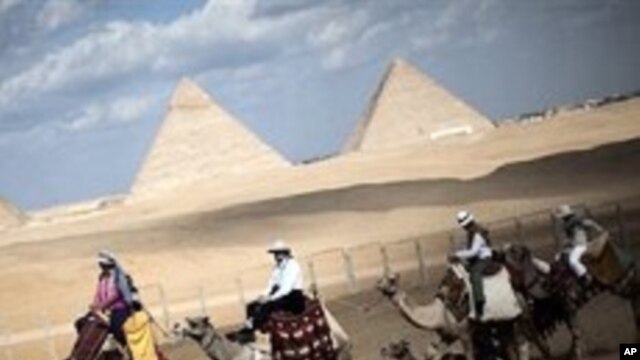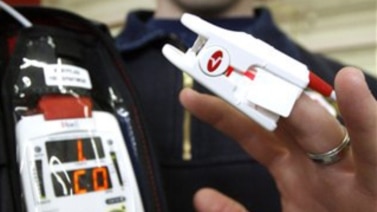
From VOA Learning English, this is Science in the News. I’m Christopher Cruise.
And I’m Kelly Jean Kelly. Today we tell about summer ice loss in parts of Antarctica. We also tell how unrest in Egypt has hurt the country’s travel industry. But it has led to the return of the scientist formerly responsible for the famous pyramids. And we report on the recent Microsoft Imagine Cup, a technology competition for students.
Scientists are learning new things about Antarctica, the coldest place on Earth. For example, the Antarctic ice sheet is shrinking. A new study found that summer ice loss in parts of Antarctica was at its highest level in 1,000 years. The study showed that Antarctic ice was melting mostly from below ice shelves, where the water is warmer than the ice.
Ice shelves are the floating edges of the ice sheet – the ice cover - that extend over ocean waters. The study is the first complete look at all of the continent’s ice shelves.
Eric Rignot is an earth system expert at the University of California, Irvine. He also works for the American space agency, NASA. There he serves as senior research scientist at NASA’s Jet Propulsion Laboratory, also in California.
He says ice melting from below is responsible for 55 percent of the shelf loss from 2003 to 2008. That is a much higher rate than scientists thought earlier.
“We find that the melting of the underside of the ice shelves is even larger than the production of icebergs. So it is the dominant process of mass removal in the Antarctic.”
Professor Rignot and his team used satellite observations, radar and computer models to measure features above the ice to learn what was going on below.
“So that includes the velocity of the ice, the thickness of the ice, how fast the freeboard (height of ice above sea level) of the ice shelf is changing with time and also how much snowfall there is on the top of the ice shelves.”
The measurements show differences from one area to the next around the continent. The major ice shelves are called Ross, Filchner and Ronne. They make up two-thirds of Antarctica’s ice shelves. But they are responsible for only 15 percent of the melting ice.
At the same time, about ten smaller ice shelves produced half the total water from ice melting during the same period. The smaller ones are found along the edges of comparatively warm water. Professor Rignot describes the importance of the information.
“That means that during warming of the climate where the properties of the Southern Ocean are changing, they may be changing faster than other oceans in the world. We may be in a situation where the coastline of Antarctica may be changing at a faster pace than we thought in the past.”
The professor says even small changes, like changes in ocean flow driven by wind, can make a huge difference in the melting of the ice shelf.
“If the wind regime changes in the Southern Ocean, it is going to change the way the ocean heat is distributed on the coast. And that’s going to affect glaciers.”
Sixty percent of the Earth’s fresh water is held in the huge Antarctic ice sheet. Professor Rignot says the study will help experts predict how the continent reacts to warmer ocean waters and helps to cause rising sea levels around the world. The study was published in the journal Science.
Politics Affects Science in Egypt
The ouster of Egypt’s President Mohamed Morsi is the latest governmental change for a country that removed another leader from office just two years ago. Before that, Hosni Mubarak ruled Egypt for nearly 30 years, from 1981 until 2011.
The changes are historic. But they have come at a huge cost to the country’s tourism industry. Rebellion shook the streets of Egypt two years ago. Until that time, the country earned a lot of money from tourists.

The loss of business is now a daily reality for Magdi Sheko, who sells gifts in the capital. He says Egypt’s continual unrest has frightened travelers. He calls the economy a disaster.
“There is no business, by the way. We are dying here. We are broke.”
It is not just Cairo souvenir sellers who are suffering. Saeed has been selling small keepsakes at the Giza Pyramids for 45 years. He says that a year ago, sales were good. But now business activity has decreased. He says supporters of the ousted president, Mohamed Morsi, are making too many problems.
Workers like Saeed depend on money spent by tourists who come to see Egypt’s pyramids and other ancient sites. Many workers blame unrest on Egypt’s streets and President Morsi’s Islamist rule for their problems.
Before the most recent violence, many Egyptians hoped that the tourist trade would begin to recover. The reason for that hope was that Zahi Hawass has apparently been returned as a spokesman for the country’s antiquities trade. For about 10 years, Mr. Hawass served as the top official for the famous pyramids. As such, he enjoyed great popularity and helped bring many tourists to Egypt.
Zahi Hawass is known for his ability to make difficult science easier for people to understand. His welcoming personality made him popular as the star of several television programs about his country.
Perhaps best of all for Egypt, he organized an exhibit called “Tutankhamen and the Golden Age of the Pharaohs” and took it overseas. The exhibit was shown in a number of major cities, from the United States to Australia. It earned his country millions of dollars.
Not everyone likes or approves of Mr. Hawass, however. Both local and foreign archeologists have criticized his scientific and administrative methods. He lost his job in 2011, after keeping it for a while after President Mubarak was forced from office.
The Morsi government then investigated him on suspicion of unlawful activities and banned him from traveling outside Egypt. The accusations included giving illegal permission for artifacts to leave Egypt. He denies any wrongdoing.
Now that the government has changed again, Zahi Hawass recently launched a world speaking tour to help his country’s antiquities tourist trade. Tour groups led by him are being advertised online. They include visits to places like the Great Sphinx and the tomb of the ancient ruler of Seti the First.
Entry is offered to the Step Pyramid at Saqqara through a special entrance inside the centuries-old stone structure. That entrance is not open to the general public. And, Mr. Hawass is also leading a private tour to the Great Pyramid of Khufu.
He says there may be an area in the Great Pyramid leading to a secret burial chamber filled with treasure. The archeologist spoke recently in Toronto, Canada about research performed by robots in that structure. One room in the pyramid is called the Queen’s Chamber. It contains two shafts, or openings, but they do not lead to the outside surface of the pyramid. The robots exploring these shafts have found mysterious doorways that do not open.
The possibilities could be exciting. That is because the burial place of the great pharaoh has never been found in the many centuries since his death. And Mr. Hawass believes that Khufu’s burial area may contain objects of great value.
Exciting discoveries in the Great Pyramid of Khufu could help the directors of a Nile River pleasure boat called the Armada. Thirty cooks work on the boat. But the Armada’s general manager says there is almost nobody to eat the food prepared by the cooks. Ziad El Minabbawe mourns the situation.
“The tourism is one of our biggest income after the Suez Canal. So you can imagine what happens to your second biggest income when it drops 90 percent. It is a catastrophe.”
Mahmoud Atif Tartour learned the camel business from his father and grandfather. But without people wanting to ride the animals, he has had to sell four of his 12 camels. The businessman worries about the future.
“There is no tourists. How will we work? How will we feed our camels? How will we feed ourselves? So, we can’t. We actually can’t handle this one more year. It is going to kill us like that.”
Mr. Tartour thinks that things will settle down now that the Muslim Brotherhood is out of power. And like so many others who need visitors to Egypt to feed their families, he hopes that the visitors will return.
Students Compete for Science Prize in Russia
Finally, the Microsoft Imagine Cup Worldwide Finals took place last month in St. Petersburg, Russia. This was the 11th year Microsoft Corporation has organized the technology competition for students.
This year, more than 300 students from 71 nations competed in the finals. The winning teams were from the United Kingdom, Austria and Portugal.
Team Colinked won first place for Innovation for its SoundSYNK mobile phone app. The program creates social networks by linking nearby mobile telephones to play the same song, all in perfect harmony.
A team from Portugal won first place in the World Citizenship category. Its software program, called For a Better World, helps identify a patient’s blood type quickly in emergency situations. And, Team Zeppelin Studio from Austria won first place in the Game Design competition. All the winning teams received a $50,000 prize.
This Science in the News was written by Jerilyn Watson and June Simms, who was also our producer. I’m Kelly Jean Kelly.
And I’m Christopher Cruise. Join us again next week for more news about science on the Voice of America.



